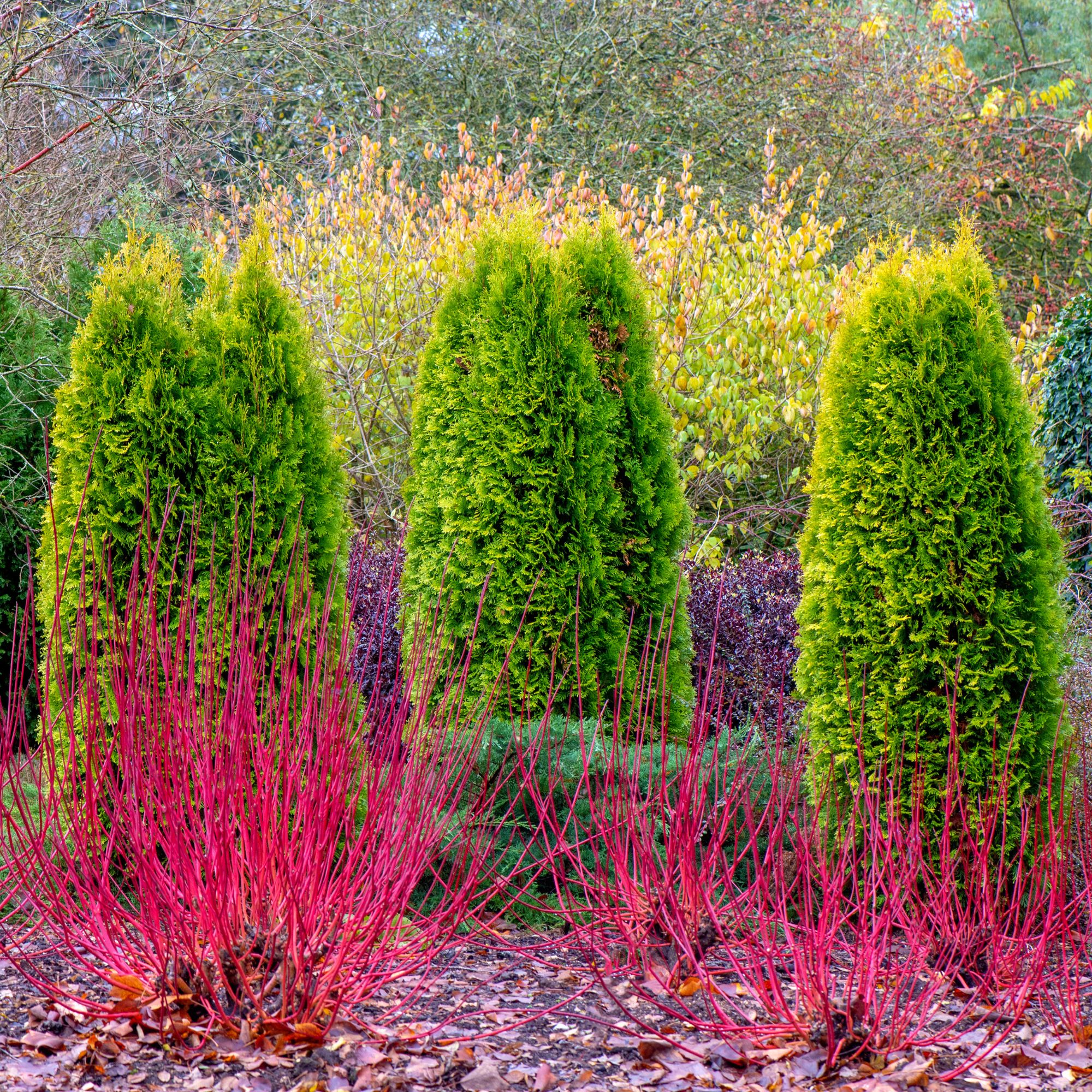How to prune dogwoods for brightly-coloured stems year after year
Dogwoods are one of the best ways to transform your garden. So, how best to prune them?


With their firework hues and structural appeal, cornus (aka dogwoods) are more popular than ever. So, how to prune dogwoods if you want them to look their colourful best with each passing year?
One of the easiest ways to add colour to a winter garden, dogwoods are often counted among the best winter flowers that bloom at Christmas in spite of the fact they're not grown for their blooms but for their dazzling winter stems.
While they're guaranteed to breathe life into your outdoor space well after the first frosts dogwoods need some love if you want them to keep doing their thing. This means, yes, you need to learn how to prune them like a pro.
'Dogwoods are very easy to grow and provide stunning winter colour to break up the grey sky. Still, it's the stems that provide the colour, so pruning once a year is advisable if you want to keep them vibrant,' says Morris Hankinson, director of Hopes Grove Nurseries.

Morris Hankinson is the founder and managing director of Hopes Grove Nurseries Ltd, the UK’s only specialist grower-retailer of hedging plants. He established the thriving business in 1992, shortly after graduating with a Commercial Horticulture Degree from Writtle College, Essex.
Noting that this is a job to be done in the springtime, Morris adds that dogwoods 'do not need to be pruned every year, and can easily go two to three years without being pruned'.
'The only difference with leaving them is the colourful stems will fade and they may become a bit messy,' he says.
What you will need
Unlike some big gardening jobs, you won't need much in the way of equipment when you set to learning how to prune dogwoods; a pair of secateurs, obviously, will be needed for the cutting itself. And you'll likely want a trug or bag to collect your clippings in, too.
Finally, be sure to wear a pair of gardening gloves, for safety's sake!

These secateurs have over 28,000 Amazon reviews with an average rating of 4.5, so they'll definitely be handy to have when pruning dogwoods.
How to prune dogwoods guide
Now that you have all of your equipment to hand, it's time to dive into our How To Prune Dogwoods 101 Guide in earnest.
Flit your eyes downward, then, for the lowdown on what to do.
1. Time it right
The best time to prune dogwoods is while it's dormant in the early spring, just before the leaves appear. This allows the plant to use its resources in its roots for regrowth, and allows you to enjoy those colourful stems unhampered over the winter, too.

2. Thin things out
When determining how to prune dogwoods, Morris says it is 'advisable to prune crossing, dead, diseased or damaged stems right back to the ground'.
You should also thin some stems out to provide airflow and structure.
3. Or prune right back
Of course, you might prefer to cut the whole plant back.
'If you want those amazing stems to leave for at least two years (ideally three) to establish themselves, then prune down to 5-10 cm from the ground every two years to get coloured winter stems,' says award-winning garden designer Zoe Claymore.

Zoe Claymore is a multi award-winning garden designer based in London. She focuses on creating outdoor places with emotional connection and ecological integrity for her private and commercial clients.
The plant experts at the Royal Horticultural Society (RHS) are in firm agreement with Zoe, noting that 'all growth should be cut back hard to a stubby low framework or to ground level [...] every couple of years if you wish'.
4. Get mulching
The final step when learning how to prune dogwoods is simple enough; show them some love once you've finished the job.
'Make sure you've mulched around the base of the plant with some well rotted organic matter,' advises Morris.
The RHS, meanwhile, adds that you should 'apply a balanced general-purpose fertiliser at 70g per square metre each spring to support stem and flower growth'.

FAQs
When should dogwood be pruned?
If you're wondering when dogwood should be pruned, it's best to set to work in the early springtime (from late march to mid-April), just as the new growth is developing. This should give you ample time to enjoy their vibrant stems over the winter!
How to prune cornus alba dogwood?
Young plants will need a year or two to establish themselves before you start hard-pruning, but then you can cut them down to around 5-7cm every two or three years.
'If you are going to prune back the whole dogwood, this can be done at the same time of year (early March ideally), again prune with sharp, clean secateurs all the way back down to the ground,' adds Morris Hankinson of Hopes Grove Nurseries.
Now that you know how to prune dogwoods, you can settle back and enjoy all of their bright colour over the winter in peace. Just be sure to grab a pair of secateurs once spring rolls around, as you won't want to miss out on having your cornus looks its very best next year.
Get the Ideal Home Newsletter
Sign up to our newsletter for style and decor inspiration, house makeovers, project advice and more.

Kayleigh Dray became Ideal Home’s Acting Content Editor in the spring of 2023, and is very excited to get to work. She joins the team after a decade-long career working as a journalist and editor across a number of leading lifestyle brands, both in-house and as a freelancer.
-
 5 signs you’ve taken decluttering too far — and how you can pull yourself back, according to organisation experts
5 signs you’ve taken decluttering too far — and how you can pull yourself back, according to organisation expertsYou might have to start resisting the urge to purge
By Lauren Bradbury
-
 What is the Party Wall Act 3m rule and is it something you should be worried about? This is what the experts say
What is the Party Wall Act 3m rule and is it something you should be worried about? This is what the experts sayDon't get caught off-guard by the Party Wall Act 3m rule — our expert guide is a must-read
By Natasha Brinsmead
-
 Shoppers can’t get enough of The Range’s lemon tree, but I’ve found an even cheaper bestseller at B&Q - it’s perfect for a Mediterranean look
Shoppers can’t get enough of The Range’s lemon tree, but I’ve found an even cheaper bestseller at B&Q - it’s perfect for a Mediterranean lookWelcome the summer with this glorious fruit tree
By Kezia Reynolds
-
 Shoppers can’t get enough of The Range’s lemon tree, but I’ve found an even cheaper bestseller at B&Q - it’s perfect for a Mediterranean look
Shoppers can’t get enough of The Range’s lemon tree, but I’ve found an even cheaper bestseller at B&Q - it’s perfect for a Mediterranean lookWelcome the summer with this glorious fruit tree
By Kezia Reynolds
-
 I'm a stylist with an eye for expensive-looking high street finds – these 6 garden furniture pieces at Dunelm are on my radar
I'm a stylist with an eye for expensive-looking high street finds – these 6 garden furniture pieces at Dunelm are on my radarThese pieces all look more than their price tag
By Laurie Davidson
-
 The 6 outdoor lights from Habitat that I'm choosing between to make my outdoor space look more expensive this summer
The 6 outdoor lights from Habitat that I'm choosing between to make my outdoor space look more expensive this summerI couldn’t believe some of the prices
By Ellis Cochrane
-
 Aldi is launching a £200 day bed with four different features - its sleek design is suited to the whole family
Aldi is launching a £200 day bed with four different features - its sleek design is suited to the whole familyYou don't want to miss out on this Specialbuy
By Kezia Reynolds
-
 I’m seeing pastel garden furniture at all my favourite brands this spring, but QVC’s sorbet collection impressed me the most
I’m seeing pastel garden furniture at all my favourite brands this spring, but QVC’s sorbet collection impressed me the mostFresh pastel shades are a great way to liven up your outdoor space
By Kezia Reynolds
-
 I spent the afternoon looking through Wayfair's garden sale – these are the 6 pieces I'm buying immediately for summer
I spent the afternoon looking through Wayfair's garden sale – these are the 6 pieces I'm buying immediately for summerThese are my must-have garden buys from the sale
By Holly Reaney
-
 I’ve found the perfect alternative to John Lewis’ sold-out striped garden chair – and you won’t believe where it's from
I’ve found the perfect alternative to John Lewis’ sold-out striped garden chair – and you won’t believe where it's fromJohn Lewis' Sling Garden Chair is one of the most stylish pieces of garden furniture I'd seen – until I tracked down this QVC lounge chair...
By Kezia Reynolds
-
 Lidl is selling a smart tiered planter that will unlock extra planting space in a tiny garden or balcony
Lidl is selling a smart tiered planter that will unlock extra planting space in a tiny garden or balconyWhy I've been eyeing this planter up for my tiny garden
By Kezia Reynolds

